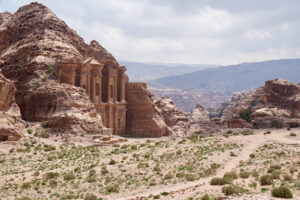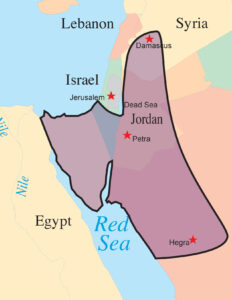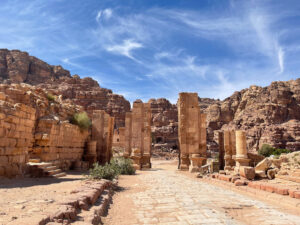By Dr. Don Bierle, FaithSearch President
Travel about fifty miles south of the Dead Sea, take a nearly mile-long donkey ride through a narrow rock-carved gorge called the Siq, and emerge before the stunning rock-cut façade of the Khazneh (“Treasury”). You stand there with fascination and awe. You have just repeated the experience of a million tourists in 2022. Tucked away in the red sandstone cliffs of southern Jordan, Petra was named a UNESCO World Heritage Site in 1985, and in 2007 it was named one of the new seven wonders of the world.
I had the privilege to visit the site in the late 1970s. More about Petra and the Nabateans has been discovered since then, some of which I want to explore in this brief feature.
Who were the Nabateans?
- A Hellenized (“made Greek”) Arab nation, reaching the zenith of its power and influence from 300 B.C.-A.D. 100. There is not even a mention of it in the New Testament, although it was a southern and eastern neighbor of Israel during the time of Jesus.
- Descendants of Ishmael (Abraham’s son through Hagar [Genesis 25:12]), originating in Saudi Arabia as nomadic tent dwellers and herders in the fifth through sixth centuries B.C. They eventually “inhabited all the country from the Euphrates to the Red Sea and called it Nabatene,” named after the oldest son Nabaioth (according to Josephus, Antiquities of the Jews, 1.12.4, written ca. A.D. 94). [This claim is disputed by some modern scholars.]
- Developed a lucrative commercial trade empire extending from India to Rome, moving Eastern goods (spices, frankincense, oil, copper, sugar, ivory, etc.) to Western markets via the ports of Gaza and Alexandria on the Mediterranean.
- The Nabatean desert community flourished due to their skill in desert agriculture and the harvesting of rainwater through a system of channels, dams, aqueducts, and cisterns. They were also extremely talented in rock sculpturing and architecture.
- In A.D. 106 the Nabatean Kingdom was annexed as a province of Rome called Arabia Petraea.
Petra

Early in its history, Petra (its Greek name, meaning “rock”; “Rekem” originally) was just a link along a major trade route, the so-called spice road. As the Nabateans became wealthy, Petra, by the first century B.C., had become a full-fledged capital built as a first-order Greco-Roman city ruled by Western-looking kings.
Most striking are the dazzling stone-carved structures – mostly tombs of the Nabatean royals and elites. For example, there is the iconic “Treasury” as the tomb of king Aretas IV who reigned in the first century A.D.; and the largest of Petra’s monuments, Ad Deir, standing at a stunning 148 feet tall and 160 feet wide. Petra also had an impressive Greco-Roman theater carved into rose-colored sandstone bedrock which seated at least 600 people. The city attained a population of at least 20,000.

Beyond the theater was a wide, half-mile long stone-paved and colonnaded thoroughfare flanked on all sides by the key institutions of the city’s Hellenistic life. There were luxurious pools and gardens, a bustling market, and opulent shrines dedicated to their pagan gods and goddesses. On a hill overlooking main street was Petra’s high-rent district where wealthy citizens owned villas adorned with colorful frescoes and furnished with the finest of imported wares.
When did Petra and the Nabateans intersect with the Bible?
- The Gospels: King Aretas IV’s daughter married Herod Antipas, the son of Herod the Great (whose mother and father had Nabatean roots). When Antipas divorced her to marry Herodias (his brother Philip’s wife, see Mark 6:17-19) Aretas sought revenge by attacking Antipas and secured some of his territory all the way to Damascus.
- Paul: After his conversion to Jesus on the Damascus Road, he said that he went to “Arabia” for three years (Galatians 1:17). This was not today’s Saudi Arabia but rather Petra, the capital of the Arab Nabateans. It is speculation, but some believe that Paul preached the Gospel in Petra (illegally!) and got the attention of king Aretas. When Paul returned to Damascus and preached the Gospel in the synagogues there, the Jews sought to kill him (Acts 9:23-25). Paul later recounted this event (2 Corinthians 11:32) and stated that it was actually the Nabatean king Aretas who ordered the governor and the Jews in Damascus to arrest or kill Paul.
- Jewish/Nabatean Intermarriage: As allies with the ruling Jewish Hasmonean Dynasty in the first and second centuries B.C., some Nabateans converted to Judaism and intermarried. By the time of Jesus, the Herodian dynasty and many of the elites of society in Israel were of Nabatean stock.
- Tribulation Period: Finally, some Christians have speculated that Petra may play a role in the tribulation period of the end times, believing it to be the location referred to in Revelation 12:9 – “And the woman [Israel] fled into the wilderness where she had a place prepared by God…”
Petra’s Later History
- Byzantine Christians and Churches: Petra declined until Constantine became Emperor of Rome in the fourth century. He wanted to advance Christianity throughout the empire and Christian churches were constructed there by the Byzantines, who considered Petra to be the capital of the province of Palaestina. Recently (1993), 140 papyri (Petra Scrolls) were discovered in a church there which provide valuable information that the city was flourishing in the sixth century. Christian occupation in Petra ended with the Muslim conquest early in the seventh century.
- The city declined rapidly during the Islamic era until it was abandoned. Petra then remained unknown to the western world until 1812, when Swiss traveler Johann Ludwig Burckhardt rediscovered it.
- Since then, it has been the site of extended archaeological activity, a thriving tourism industry, and the dramatic climax scene of the 1989 film Indiana Jones and the Last Crusade.
Conclusion
Despite being founded in paganism, we can be certain that the Nabateans existed only by the providential will of God and that He desired them to serve the living God: “…He made from one, every nation of mankind to live on all the face of the earth, having determined their appointed times, and the boundaries of their habitation, that they should seek God, if perhaps they might grope for Him and find Him…” (Acts 17:26-27).
Is this why God directed Paul to Arabia (Petra) for three years before sending him west to the Gentiles (Galatians 1:17)? We can assume that the Nabateans were given an opportunity to turn from idols to faith in the resurrected Lord Jesus Christ (vv. 30-31). Some day we will know if any “found” Him!
Sources: “When People Lived at Petra,” Joseph J. Basile, Archaeology Odyssey, July-August 2000; “OnSite: Petra, Nathan Steinmeyer and Glenn Corbett,” Bible History Daily, April 21, 2023; “Solving the Enigma of Petra and the Nabataeans,” Glenn Corbett, Bible History Daily, Nov. 6, 2022; “Paul of Arabia?” Ben Witherington III, Biblical Archaeology Review, Winter 2021, pp. 60-61.





